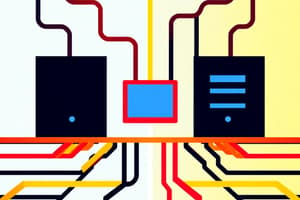Podcast
Questions and Answers
In a client/server network, what role best describes the function of the central computer?
In a client/server network, what role best describes the function of the central computer?
- To facilitate communication and resource sharing. (correct)
- To run local applications independently.
- To prevent any resource sharing between users on the network.
- To store data locally only.
Which of the following is a primary advantage of a peer-to-peer network compared to other network models?
Which of the following is a primary advantage of a peer-to-peer network compared to other network models?
- Greater flexibility for expansion
- Simplified configuration and lower cost (correct)
- Enhanced security features
- Centralized network management
What characteristic differentiates a MAN (metropolitan area network) from a LAN (local area network)?
What characteristic differentiates a MAN (metropolitan area network) from a LAN (local area network)?
- A MAN connects clients and servers across multiple buildings in a city. (correct)
- A MAN primarily uses the same transmission media as a LAN.
- A MAN is confined to a smaller geographical area.
- A MAN is typically less expensive to install.
What function does a Network Interface Card (NIC) provide in a computer?
What function does a Network Interface Card (NIC) provide in a computer?
Which of the following best describes the purpose of 'addressing' in the context of network communications?
Which of the following best describes the purpose of 'addressing' in the context of network communications?
Why is flexibility considered a key disadvantage of peer-to-peer networks when compared to client/server networks?
Why is flexibility considered a key disadvantage of peer-to-peer networks when compared to client/server networks?
What is a key characteristic of a WAN (wide area network)?
What is a key characteristic of a WAN (wide area network)?
Which network component is responsible for managing shared resources in a client/server network?
Which network component is responsible for managing shared resources in a client/server network?
What role does a 'backbone' play in network architecture?
What role does a 'backbone' play in network architecture?
What is the primary function of a Network Operating System (NOS)?
What is the primary function of a Network Operating System (NOS)?
Which of the following is NOT a typical network service?
Which of the following is NOT a typical network service?
In the context of network management, what is the function of 'traffic monitoring and control'?
In the context of network management, what is the function of 'traffic monitoring and control'?
How does a client workstation typically interact with a server in a client/server network regarding applications?
How does a client workstation typically interact with a server in a client/server network regarding applications?
What is the key consideration when choosing fiber optics for a metropolitan area network (MAN)?
What is the key consideration when choosing fiber optics for a metropolitan area network (MAN)?
Which of these options is most indicative of a peer-to-peer network environment?
Which of these options is most indicative of a peer-to-peer network environment?
What function does 'load balancing' perform in network management?
What function does 'load balancing' perform in network management?
When referring to a 'node' in a network, which of the following can it be?
When referring to a 'node' in a network, which of the following can it be?
What is the impact of using long-distance telecommunication networks to create a WAN?
What is the impact of using long-distance telecommunication networks to create a WAN?
What is a key capability when a file server provides 'file services'?
What is a key capability when a file server provides 'file services'?
In a client/server environment, what is a key difference in the hardware specifications of servers compared to clients?
In a client/server environment, what is a key difference in the hardware specifications of servers compared to clients?
Which network topology involves a direct connection from each network device to a central hub or switch?
Which network topology involves a direct connection from each network device to a central hub or switch?
What would be the best setup for a small business that needs a centralized management and high security level?
What would be the best setup for a small business that needs a centralized management and high security level?
What is the key function offered via a communications server?
What is the key function offered via a communications server?
If a company wants to provide LAN connectivity when WAN is not cost-effective, what feature needs to be implemented?
If a company wants to provide LAN connectivity when WAN is not cost-effective, what feature needs to be implemented?
If an administrator has to determine how many copies of an application are currently in use in a network and ensure that the number of copies doesn't exceed the license, what process should be used?
If an administrator has to determine how many copies of an application are currently in use in a network and ensure that the number of copies doesn't exceed the license, what process should be used?
To ensure security measures as per the network Administrator and notify in case of breach of security where security measures are in force, what should be deployed?
To ensure security measures as per the network Administrator and notify in case of breach of security where security measures are in force, what should be deployed?
What element is required to enable communication between devices in the network?
What element is required to enable communication between devices in the network?
Which of the network below provides a wide range of Network Services?
Which of the network below provides a wide range of Network Services?
What is a distinct characteristic for a host device?
What is a distinct characteristic for a host device?
Flashcards
What is a network?
What is a network?
A group of computers and devices connected by a transmission medium.
What is a stand-alone computer?
What is a stand-alone computer?
A computer that isn't connected to any other computers and uses its own local software and data.
What is a peer-to-peer network?
What is a peer-to-peer network?
A network model where each computer has equal authority and can share resources directly with others.
Advantages of peer-to-peer networks?
Advantages of peer-to-peer networks?
Signup and view all the flashcards
Disadvantages of peer-to-peer networks?
Disadvantages of peer-to-peer networks?
Signup and view all the flashcards
What is a Client/Server network?
What is a Client/Server network?
Signup and view all the flashcards
What is a server?
What is a server?
Signup and view all the flashcards
What are clients?
What are clients?
Signup and view all the flashcards
Centralized Resources
Centralized Resources
Signup and view all the flashcards
Communication in Client/Server?
Communication in Client/Server?
Signup and view all the flashcards
Server Features
Server Features
Signup and view all the flashcards
Client/Server Advantages
Client/Server Advantages
Signup and view all the flashcards
What is a LAN?
What is a LAN?
Signup and view all the flashcards
What is a MAN?
What is a MAN?
Signup and view all the flashcards
What is a WAN?
What is a WAN?
Signup and view all the flashcards
Elements Common to Client/Servers
Elements Common to Client/Servers
Signup and view all the flashcards
Client Roles
Client Roles
Signup and view all the flashcards
What is a workstation?
What is a workstation?
Signup and view all the flashcards
What is a NIC?
What is a NIC?
Signup and view all the flashcards
What is NOS?
What is NOS?
Signup and view all the flashcards
What is a node?
What is a node?
Signup and view all the flashcards
Connectivity devices
Connectivity devices
Signup and view all the flashcards
What is a segment?
What is a segment?
Signup and view all the flashcards
What is a backbone?
What is a backbone?
Signup and view all the flashcards
What is Topology?
What is Topology?
Signup and view all the flashcards
What is a protocol?
What is a protocol?
Signup and view all the flashcards
What is a packet?
What is a packet?
Signup and view all the flashcards
What is addressing?
What is addressing?
Signup and view all the flashcards
Network Services
Network Services
Signup and view all the flashcards
What is Convergence?
What is Convergence?
Signup and view all the flashcards
Study Notes
- A network is a group of computers and devices connected by transmission media.
- Stand-alone computers are not connected to other computers and use local software and data.
- Networks facilitate device sharing, save money and time, and enable central network management.
- Network models include peer-to-peer and client/server.
Peer-to-Peer Networks
- Involve direct computer communication with equal authority among devices.
- Enable individual resource sharing, with the option to prevent access to certain resources.
- Consist of two or more general purpose computers capable of sending/receiving data to/from every other computer.
- Simple to configure and less expensive than other network models.
- Can be inflexible and not necessarily secure and are not practical for large installations.
- Environments for peer-to-peer include small home or office networks.
- Newer peer-to-peer networks over the Internet are known as P2P networks.
- Examples: Gnutella, Bitcoin, original Napster, and BitTorrent software.
Client/Server Networks
- Clients are personal computers, also know as workstations.
- Centralized resource sharing is controlled by a server.
- It shares data, storage space and devices.
- There is no direct sharing of client resources.
- Server roles include running local applications and storing data locally and using a server as intermediary.
- Client/server communication occurs through switches or routers.
- Servers require a network operating system to:
- Manage client data and resources
- Ensure authorized user access
- Control and restrict user file/network access
- Dictate computer communication rules
- Supply applications to clients
- Server examples: UNIX, Linux, Microsoft Server 2008 R2, MAC OS X Server
- Servers have more memory, processing, and storage capacity.
- They are equipped with special hardware and provides network management functions
- Client/server networks involve more complex design and maintenance relative to peer-to-peer networks.
- Client/server networks share advantages relative to peer-to-peer networks:
- User credentials can be assigned from one place
- Multiple shared resources access is centrally controlled.
- Central problem monitoring, diagnostics, and correction capabilities exist.
- Optimized to handle heavy processing loads.
- The ability to connect many computers on a network.
- Increased scalability.
Network Geography
- LAN: a network confined to a relatively small space (classroom, school, or single building).
- LANs are inexpensive and provide higher speeds.
- In the 1980s, LANs became popular as peer-to-peer based networks.
- Today they are larger and more complex client/server networks.
- MAN: connects clients and servers from multiple buildings.
- It uses different transmission media and technology than LANs.
- Spans the distance of a typical metropolitan city
- Have higher installation and operation costs.
- Uses high-speed connections such as fiber optics
- WAN: connects two or more geographically distinct LANs or MANs.
- Employs different transmission methods and media than LAN.
- Spans a larger area than a single city.
- Uses long distance telecommunication networks, thereby increasing the cost.
- The Internet is a good example of a WAN.
- WANs provide a network connection for: - Separate offices in the same organization. - Separate offices in different organizations.
Elements Common to Client/Server Networks
- Client: requests resources or services from another network computer.
- Client workstation human user.
- Client software is installed on the workstation.
- Server: manages shared resources and it runs network operating software.
- Workstation: personal computer that might or might not be connected to a network.
- NIC (network interface card): device inside computer that connects it to network media and allows communication with other computers.
- NOS (network operating system): server software that enables the server to manage data, users, groups, security, applications and other networking functions.
- Host: a computer enables network resource sharing by other computers.
- Node: a client, server, or other device that communicates over a network and is identified by a unique network address.
- Connectivity device: allows multiple networks or multiple parts of one network to connect and exchange data.
- Segment: A group of nodes using the same communications channel for traffic.
- Backbone: Connects segments and significant shared devices which creates "a network of networks."
- Topology: Computer network physical layout (ring, bus, star or hybrid formation)
- Protocol: Standard method/format for communication between networked devices.
- Packet: Distinct data units exchanged between nodes.
- Addressing: Scheme for assigning a unique identifying number to every node.
- Transmission media: Means through which data is transmitted and received.
How Networks Are Used:
-
Network services: functions provided by a network
- Printer sharing
- File sharing
- Internet access and Web site delivery
- Remote access capabilities
- Voice and video services
- Network management
-
File and Print Services: file services provide a foundation of networking.
- The capability of server to share data files, applications and disk storage space is useful.
- Provides file services.
- It shares printers across network and saves time and money.
-
Access Services: allow remote user network connection.
-
Allows network users to connect to machines outside the network
-
The Remote Access Server, known as Access Server.
-
Communications Services
- Convergence: Offering multiple types of communications services on the same network.
- Unified communications: Centralized management of multiple network-based communications.
- Mail server: Computer responsible for e-mail storage and transfer.
-
Internet Services
- Web server: Computer installed with appropriate software to supply Web pages to different clients upon demand.
- File transfer capabilities.
- Internet addressing schemes.
- Security filters.
- Means for directly logging on other Internet computers.
- Web server: Computer installed with appropriate software to supply Web pages to different clients upon demand.
-
Management services:
- Small network management: Single network administrator
- Today’s larger network management: Centrally administered network management tasks
-
Important Network Management Services :
-
Traffic monitoring and control: Determines how much traffic is taking place on a network and notifying administrator when network becomes over loaded.
-
Load balancing: Distributes the data transfers activity evenly.
-
Hardware diagnosis and failure alert: Determines when a network component fails and automatically notifies the network administrator through a text message or email.
-
Asset management: Collects and stores the data on number and types of software and hardware assets in an organization’s environment.
-
License tracking: Determines how many copies of single application are currently in use in network and ensure that the number of copies does not exceed.
-
Security auditing: Evaluates what security measures are currently in force and notify net work administrator if security breach occurs,
-
Address management: Centrally manage a finite number of network addresses for the whole network.
-
Software distribution: Automatically transfers a file or installs an application from the server to the client on the network.
-
Backup and restoration of data: Backs up critical data files to a secure storage area and then restores data if the original files are last or deleted.
Studying That Suits You
Use AI to generate personalized quizzes and flashcards to suit your learning preferences.




